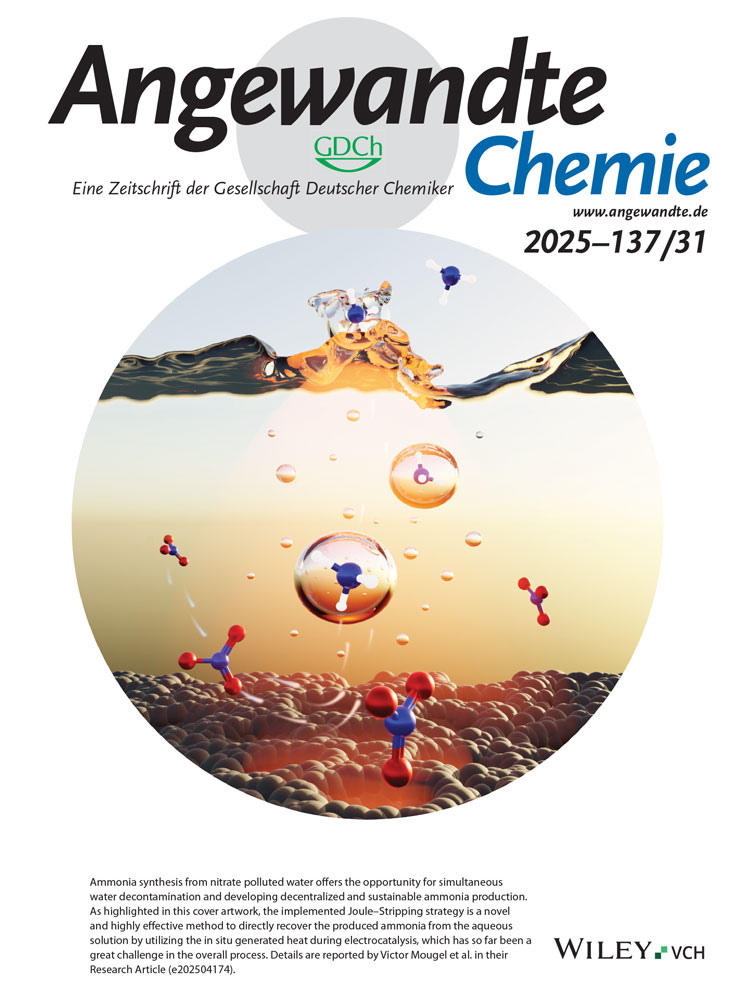Molekulare Gefäße auf Calix[5]aren-Basis für Alkylammonium-Ionen
Francoise Arnaud-Neu
Laboratoire de Chimie-Physique de l'ECPM, Université Louis Pasteur, Strasbourg
Search for more papers by this authorSaowarux Fuangswasdi
Laboratoire de Chimie-Physique de l'ECPM, Université Louis Pasteur, Strasbourg
Search for more papers by this authorAnna Notti
Dipartimento di Chimica Organica e Biologica, Università di Messina
Search for more papers by this authorSebastiano Pappalardo
Dipartimento di Scienze Chimiche, Università di Catania, Viale A. Doria 6, I-95125 Catania (Italien), Telefax: Int. +95/580-138
Search for more papers by this authorMelchiorre F. Parisi
Dipartimento di Chimica Organica e Biologica, Università di Messina
Search for more papers by this authorFrancoise Arnaud-Neu
Laboratoire de Chimie-Physique de l'ECPM, Université Louis Pasteur, Strasbourg
Search for more papers by this authorSaowarux Fuangswasdi
Laboratoire de Chimie-Physique de l'ECPM, Université Louis Pasteur, Strasbourg
Search for more papers by this authorAnna Notti
Dipartimento di Chimica Organica e Biologica, Università di Messina
Search for more papers by this authorSebastiano Pappalardo
Dipartimento di Scienze Chimiche, Università di Catania, Viale A. Doria 6, I-95125 Catania (Italien), Telefax: Int. +95/580-138
Search for more papers by this authorMelchiorre F. Parisi
Dipartimento di Chimica Organica e Biologica, Università di Messina
Search for more papers by this authorAbstract
InC5v-symmetrischercone-Konformation liegen die rechts als abgeflachte Pyramide abgebildeten Calix[5]arene vor. Sie stellen Hohlräume mit hoher Präorganisation für die Bildung starker 1:1-Einschlußkomplexe mit linearen Alkylammonium-Ionen zur Verfügung, die nBuNH /tBuNH
/tBuNH -Selektivitäten bis 103 erreichen. Diese Calix[5]arene fungieren außerdem als biomimetische Wirte, die mit enzymartiger Selektivität spezifisch Aminosäuremethylester einschließen. R beispielsweise Me, CO2Me.
-Selektivitäten bis 103 erreichen. Diese Calix[5]arene fungieren außerdem als biomimetische Wirte, die mit enzymartiger Selektivität spezifisch Aminosäuremethylester einschließen. R beispielsweise Me, CO2Me.
References
- 1 J. L. Sussman, M. Harel, F. Frolow, C. Oefner, A. Goldman, L. Toker, I. Silman, Science 1991, 253, 872–879.
- 2(a)
F. Diederich in
Cyclophanes
(Hrsg.: J. F. Stoddart),
Royal Society of Chemistry,
Cambridge,
1991;
10.1039/9781788010924 Google Scholar(b) P. C. Kearney, L. S. Mizoue, R. A. Kumpf, J. F. Forman, A. McCurdy, D. A. Dougherty, J. Am. Chem. Soc. 1993, 115, 9907–9919, zit. Lit.
- 3(a)
C. D. Gutsche
Calixarenes
in
Monographs in Supramolecular Chemistry,
Vol. 1
(Hrsg.: J. F. Stoddart),
Royal Society of Chemistry,
Cambridge,
1989;
(b)
Calixarenes, a Versatile Class of Macrocyclic Compounds,
(Hrsg.: J. Vicens,
V. Böhmer),
Kluwer Academic,
Dordrecht,
1991;
(c)
V. Böhmer,
Angew. Chem.
1995,
107,
785–818;
10.1002/ange.19951070704 Google ScholarAngew. Chem. Int. Ed. Engl., 1995, 34, 713–745.
- 4(a) K. Araki, H. Shimizu, S. Shinkai, Chem. Lett. 1993, 205–208; (b) G. De Iasi, B. Masci, Tetrahedron Lett. 1993, 34, 6635–6638; (c) M. Takeshita, S. Nishio, S. Shinkai, J. Org. Chem. 1994, 59, 4032–4034; (d) A. Casnati, P. Jacopozzi, A. Pochini, F. Ugozzoli, R. Cacciapaglia, L. Mundolini, P. Ungaro, Tetrahedron 1995, 51, 591–598; (e) M. Takeshita, S. Shinkai, Bull. Chem. Soc. Jpn. 1995, 68, 1088–1097.
- 5 S. Pappalardo, M. F. Parisi, J. Org. Chem. 1996, 61,
- 6 D. R. Stewart, M. Krawiec, R. P. Kashyap, W. H. Watson, C. D. Gutsche, J. Am. Chem. Soc. 1995, 117, 586–601.
- 7 Pentakis (ethoxyethoxy)-p-tert-buty-calix[5]aren wurde durch Alkylierung von1a mit EtOCH2CH2OTs und K2CO3 im Überschuß syntyetisiert. Gelöst in CDCl3 liegt zum Teil ein Gemisch der cone/cone-Konformere im Verhältnis 19: 1 bei 21°C vor, die sich langsam ineinander umwandeln.
- 8 H.-J. Schneider, R. Kramer, S. Simova, U. Schneider, J. Am. Chem. Soc. 1988, 110, 6442–6448.
- 9 G. M. Lein, D. J. Cram, J. Am. Chem. Soc. 1985, 107, 448–455.
- 10 S.-K. Chang, M. J. Jang, S.-Y. Han, Chem. Lett. 1992, 1937–1940.
- 11 S.-Y. Han, M.-H. Kang, Y.-E. Jung, S.-K. Chang, J. Chem. Soc. Perkin Trans. 2 1994, 835–839.
- 12 Y. Kubo, S. Maruyama, N. Ohhara, M. Nakamura, S. Tokita, J. Chem. Soc. Chem. Commun. 1995, 1727–1728.
- 13 E. Roberts, M. A. Sherman, Neurochem. Res. 1993, 18, 365–376.
- 14(a) L. W. Steffen, B. W. Steffen, Clin. Chem. 1976, 22, 381–383; Chem. Abstr. 1976, 84, 132283p; (b) J. L. Hoover-plow, L. A. Miles, G. M. Fless, A. M. Scanu, E. F. Plow, Biochemistry 1993, 32, 13681–13687; (c) J. M. Marshall, A. J. Brown, C. P. Ponting, Biochemistry 1994, 33, 3599–3606.
- 15 Plasminogen ist ein bekanntes Beispiel fül ein Enzym, das spezifisch Lysin und Lysin-Analoga (ω-Aminosäuren) spaltet). a) F. J. Castellino, J. R. Powell, Methods Enzymol. 1981, 80, 365–378; (b) siehd auch [ 14].
- 16 D. R. Stewart, C. D. Gutsche, Org. Prep. Proc. Int. 1993, 25, 137–139.
- 17 G. Barrett, M. A. McKervey, J. F. Malone, A. Walker, F. Arnaud-neu, L. Guerra, M.-J. Schwing-weill, C. D. Gutsche, D. R. Stewart, J. Chem. Soc. Perkin Trans. 2 1993, 1475–1479.
Citing Literature
This is the
German version
of Angewandte Chemie.
Note for articles published since 1962:
Do not cite this version alone.
Take me to the International Edition version with citable page numbers, DOI, and citation export.
We apologize for the inconvenience.




